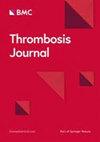Clot time ratio (CTR) and relation to treatment outcome in patients with atrial fibrillation treated with Rivaroxaban
IF 2.6
4区 医学
Q2 HEMATOLOGY
引用次数: 0
Abstract
There are situations where information about the anticoagulant effects of Rivaroxaban could be clinically useful. Methods for measuring Rivaroxaban concentrations are not available at all medical laboratories while the test MRX PT DOAC for measuring the functional effects of Rivaroxaban, in CTR (Clot Time Ratio), can be made available around the clock. The objectives of this study were to investigate CTR in trough and peak samples during Rivaroxaban treatment of atrial fibrillation and to correlate the findings to bleeding episodes. 3 trough- and 3 peak samples from 60 patients (30 on 20 mg daily and 30 on 15 mg daily) were analyzed with PT DOAC. Patients were monitored for 20 months, and bleeding and thrombotic events were documented. Descriptive statistics were used to summarize the data and non-parametric t-test for comparison between groups. ROC curves for the prediction of DOAC plasma levels > 50 ng/mL as determined with LC-MS/MS and anti-FXa methods were computed. There was a significant difference between trough and peak CTR (median CTR 1.33 vs. 3.57, p < 0.001). 28 patients suffered bleeds. Patients on 20 mg Rivaroxaban with bleeds had higher mean peak CTR than patients without bleeds (CTR 4.11 vs. CTR 3.47, p = 0.040). There was no significant difference in mean CTR between patients on 15 mg Rivaroxaban with or without bleeds (CTR 3.81 vs. 3.21, p = 0.803), or when considering all patients (CTR 3.63 vs. 3.56, p = 0.445). Five out of seven patients on Rivaroxaban 20 with mean peak CTR above the dose specific first to third quartile range (Q1-Q3) suffered bleeds, while 7/16 patients with mean peak CTR within, and 1/7 patients with mean peak CTR below the Q1-Q3 suffered bleeds. The area under the ROC curve was > 0.98 at the upper limit of the PT DOAC reference interval and the negative predictive value of PT DOAC for the prediction of DOAC plasma levels > 50 ng/mL was > 0.96. The sample size was too low to draw any firm conclusions but is seems that MRX PT DOAC might be a useful laboratory test in situations where the effect of Rivaroxaban needs evaluation.接受利伐沙班治疗的心房颤动患者的凝血时间比(CTR)及其与治疗结果的关系
在某些情况下,有关利伐沙班抗凝效果的信息可能对临床有用。测量利伐沙班浓度的方法并非所有医学实验室都能提供,而用于测量利伐沙班功能效应的 MRX PT DOAC(凝血时间比)测试却可以全天候提供。本研究的目的是调查利伐沙班治疗心房颤动期间谷值和峰值样本中的凝血时间比,并将调查结果与出血发作相关联。使用 PT DOAC 分析了 60 名患者(30 人每天服用 20 毫克,30 人每天服用 15 毫克)的 3 份波谷和 3 份波峰样本。对患者进行了长达 20 个月的监测,并记录了出血和血栓事件。描述性统计用于总结数据,非参数 t 检验用于组间比较。计算了用LC-MS/MS和抗FXa方法测定的DOAC血浆水平> 50纳克/毫升的预测ROC曲线。在 PT DOAC 参考区间的上限,谷值和峰值 CTR 之间存在显著差异(中位数 CTR 1.33 vs. 3.57,p 0.98),PT DOAC 预测 DOAC 血浆水平 > 50 ng/mL 的阴性预测值 > 0.96。样本量太少,无法得出任何确切结论,但在需要评估利伐沙班效果的情况下,MRX PT DOAC似乎是一种有用的实验室检测方法。
本文章由计算机程序翻译,如有差异,请以英文原文为准。
求助全文
约1分钟内获得全文
求助全文
来源期刊

Thrombosis Journal
Medicine-Hematology
CiteScore
3.80
自引率
3.20%
发文量
69
审稿时长
16 weeks
期刊介绍:
Thrombosis Journal is an open-access journal that publishes original articles on aspects of clinical and basic research, new methodology, case reports and reviews in the areas of thrombosis.
Topics of particular interest include the diagnosis of arterial and venous thrombosis, new antithrombotic treatments, new developments in the understanding, diagnosis and treatments of atherosclerotic vessel disease, relations between haemostasis and vascular disease, hypertension, diabetes, immunology and obesity.
 求助内容:
求助内容: 应助结果提醒方式:
应助结果提醒方式:


